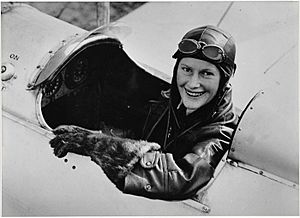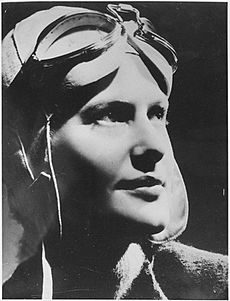Nancy Bird Walton facts for kids
Quick facts for kids
Nancy Bird Walton
|
|
|---|---|

Nancy Bird Walton in a Gipsy Moth at Kingsford-Smith Flying School (1933)
|
|
| Born |
Nancy Bird
16 October 1915 Kew, New South Wales, Australia
|
| Died | 13 January 2009 (aged 93) Sydney, New South Wales, Australia
|
| Nationality | Australian |
| Known for | Youngest woman pilot to gain a Commercial Pilot's Licence in the British Empire |
| Spouse(s) | Charles Walton |
| Awards | Officer of the Order of Australia (1990) Officer of the Order of the British Empire (1966) Centenary Medal (2001) |
| Aviation career | |
| First flight | 1933 |
| Flight license | 27 September 1933 |

Nancy Bird Walton (born October 16, 1915 – died January 13, 2009) was a famous Australian pilot. She was known as "The Angel of the Outback." She also started the Australian Women Pilots' Association.
In the 1930s, she became a fully qualified pilot at just 19 years old. This made her the youngest Australian woman to get a pilot's license.
Contents
Early Life and Flying Dreams
Nancy Bird was born in Kew, New South Wales, Australia, on October 16, 1915. She dreamed of flying from a very young age. As a teenager during the Great Depression, Nancy left school at 13. She needed to help her family.
In 1933, at age 18, her passion for flying led her to take lessons. Sir Charles Kingsford Smith had just opened a pilot school near Sydney. He was the first person to fly across the mid-Pacific Ocean. Nancy was one of his first students. Most women learned to fly for fun. But Nancy wanted to fly as her job.
Becoming a Commercial Pilot
Nancy earned her commercial pilot's license when she was 19. With some money from her great aunt and a loan from her father, she bought her first plane. It was a de Havilland Gipsy Moth.
Soon after, Nancy and her friend, Peggy McKillop, went on a flying tour. They visited country fairs. They gave joyrides to people who had never seen a plane before. Many had never even seen a female pilot.
Helping People in the Outback
During her tour, Nancy met Reverend Stanley Drummond. He asked her to help start a flying medical service. This service would help people in the outback of New South Wales. In 1935, she was hired to run this service. It was called the Royal Far West Children's Health Scheme.
Nancy's own Gipsy Moth plane was used as an air ambulance. She later bought a better-equipped plane. She began covering areas like Queensland. These places were not yet reached by the Royal Flying Doctor Service of Australia. She said the work was rewarding but also lonely.
Later Career and Achievements
In 1936, Nancy Bird entered an air race from Adelaide to Brisbane. She won the Ladies' Trophy. In 1938, she took a break from flying. A Dutch airline, KLM, invited her to do promotional work in Europe. She stayed there for a couple of years.
She returned to Australia when World War II started. She began training women in skills needed to support the men flying in the Royal Australian Air Force.
In 1950, she founded the Australian Women Pilots' Association (AWPA). She was president for five years. In 1983, Nancy-Bird Walton became the Patron of the AWPA. She returned to flying in 1958 after more than twenty years.
Honours and Recognition
Nancy Bird Walton was known for helping charities and people in need. She received several awards for her work. In 1966, she was made an Officer of the Order of the British Empire (OBE). In 1990, she was appointed an Officer of the Order of Australia (AO). She inspired many female pilots. She was never in an accident, even though early flying was risky.
The Nancy-Bird Walton Memorial trophy is given by the Australian Women Pilots' Association. It honours the most important contribution to aviation by a woman from Australia or New Zealand.
The National Trust of Australia named her an Australian Living Treasure in 1997. In 2001, she was added to the Victorian Honour Roll of Women.
The first Airbus A380 plane for the Australian airline Qantas was named after her. Her name on the plane was first "Nancy Bird Walton." But Qantas changed it to "Nancy-Bird Walton." This was how her late husband preferred to call her. This plane was involved in flight QF32 in 2010. It had an engine problem after taking off from Singapore. Nancy Bird Walton had written a reference for the first officer when he joined Qantas.
One of her last interviews was for the documentary film Flying Sheilas. This film showed her life and the lives of seven other Australian female pilots.
In March 2019, Prime Minister Scott Morrison announced a new airport. The Western Sydney Airport will be named Western Sydney International (Nancy-Bird Walton) Airport.
Personal Life
Nancy was 24 when she married Charles Walton, an Englishman. They had two children. Charles preferred to call her "Nancy-Bird" instead of "Nancy." So, she became known as "Nancy-Bird Walton."
Nancy Bird Walton passed away on January 13, 2009, at the age of 93.
See also
 In Spanish: Nancy Bird-Walton para niños
In Spanish: Nancy Bird-Walton para niños


